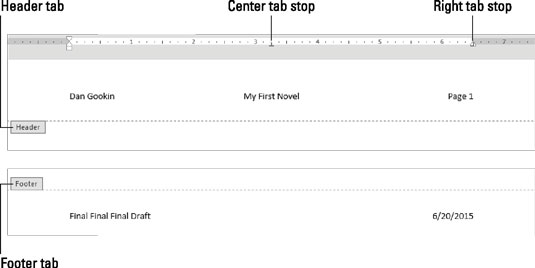When one of the preset header/footer designs in Word 2016 doesn't cut it, consider creating your own. The secret is to double-click the space at the top or bottom of the page. The header or footer area, respectively, becomes active.
You can place text or any other item, including graphics, in a header or footer. Common and useful commands appear on the Header & Footer Tools Design tab, but you can use any tab on the Ribbon to create and customize a header or footer.
To switch between the header and footer when editing, click the Go to Footer button. To switch back, click Go to Header. These buttons are found on the Header & Footer Tools Design tab in the Navigation group.
Type text in your header or footer
Any text you type in a header or footer becomes part of the header or footer. It doesn't have to be fancy text, just whatever text you want appearing at the top or bottom of every page in the document.
The standard format for lines in a header or footer includes two tab stops: A center tab stop in the middle of the page and a right tab stop aligned with the right margin. Use these tab stops, as illustrated here, to create useful header text.

Add a page number in your header or footer
It's tempting, and it seems like the obvious choice, but don't use the Page Number command on the Header & Footer Tools Design toolbar. If you need a page number in a header or footer, add a document page-number field. Follow these steps.
Position the insertion pointer where you want the page number to appear.
Click the Header & Footer Tools Design tab.
In the Insert group, click the Document Info button and choose Field.
The Field dialog box appears.
From the Categories menu, choose Numbering.
In the Field names list, click to select Page.
Choose a Format.
For example, choose the item 1, 2, 3, … to use that numbering style.
Click the OK button.
The Page field is inserted in the header. It reflects the current page number for every page printed in the document.
You don't have to go to page 1 to insert a page number in a header. Word is smart enough to place the proper number on the proper page, no matter where you're editing the header in your document.
If you want one of those "Page 3 of 45" things in a header or footer, you need two fields: The Page field as described in this section and the NumPages field. To add that field, repeat the steps here, but in Step 4 choose Document Information and in Step 5 choose NumPages.
Add the date and time to headers or footers
To place the current date or time or an updating time field in a header or footer, follow these steps:
Position the insertion pointer where you want the date or time to appear.
Click the Header & Footer Tools Design tab.
In the Insert group, click the Date & Time command button.
The Date and Time dialog box appears.
Choose a format for the date, or the time, or both.
To keep the date and time information current, place a check mark by the option Update Automatically.
Click OK.





